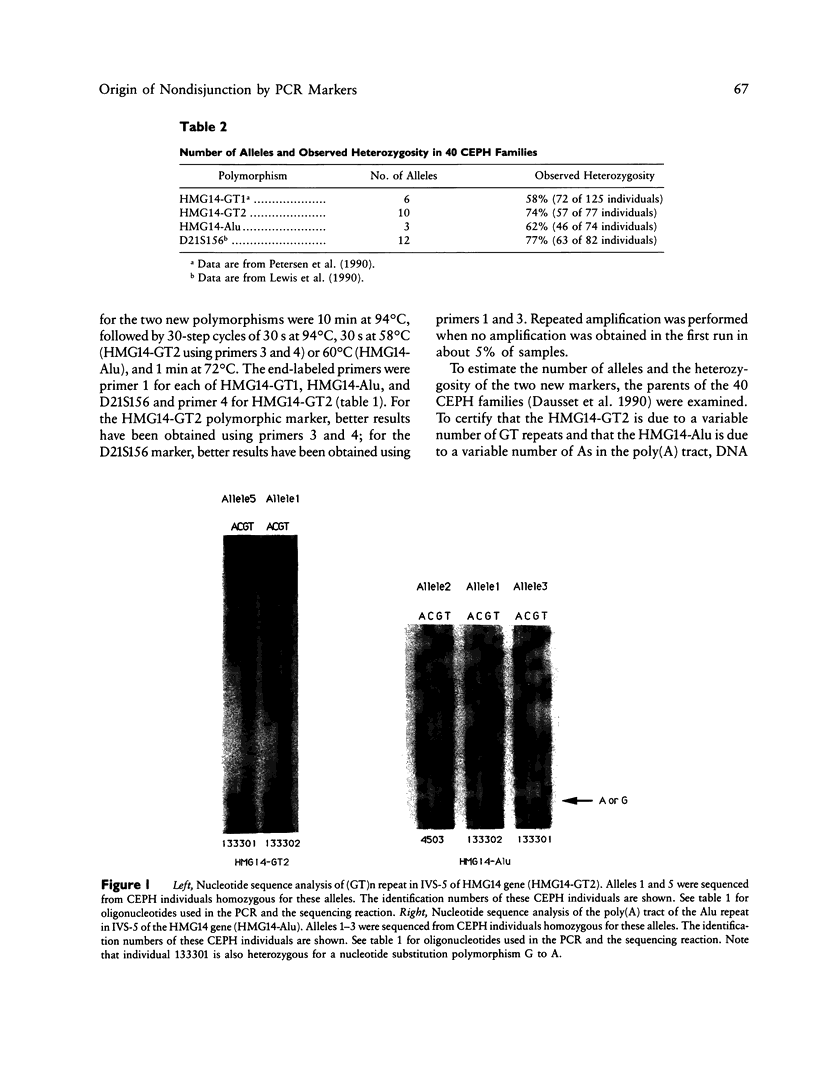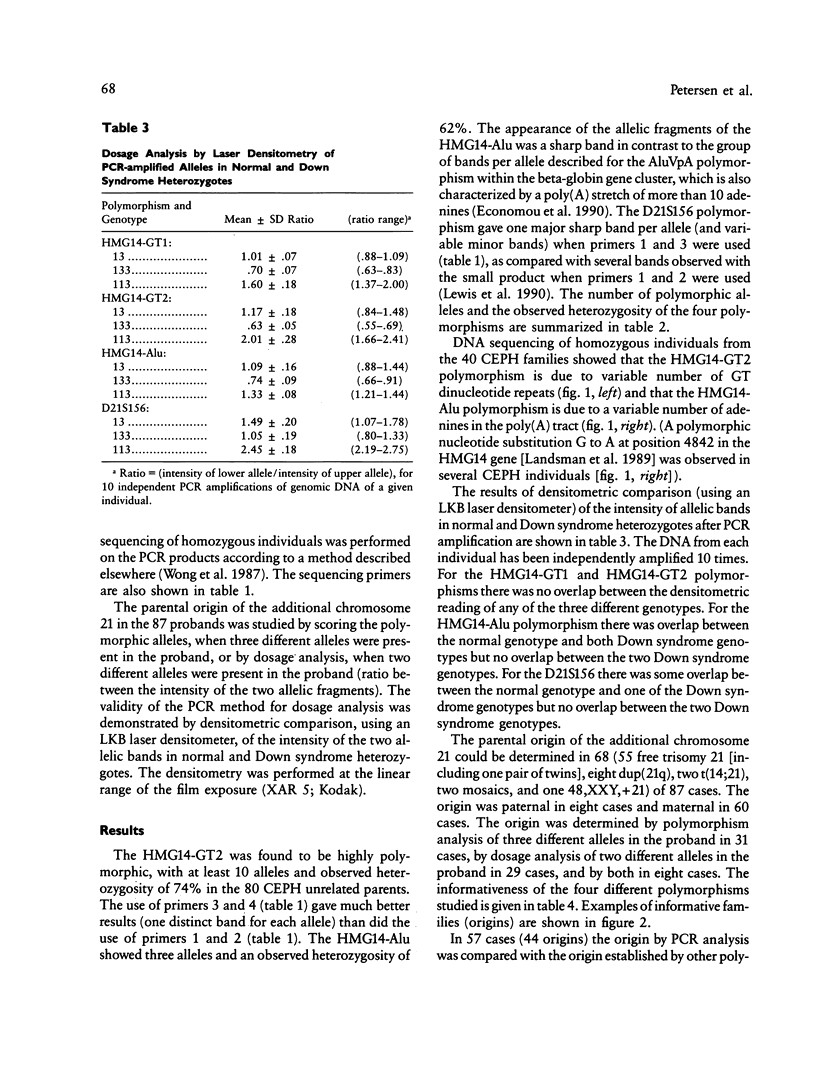Abstract
The origin of nondisjunction in trisomy 21 has so far been studied using cytogenetic heteromorphisms and DNA polymorphisms using Southern blot analysis. Short sequence repeats have recently been described as an abundant class of DNA polymorphisms in the human genome, which can be typed using the polymerase chain reaction (PCR) amplification. We describe the usage of such markers on chromosome 21 in the study of parental origin of the additional chromosome 21 in 87 cases of Down syndrome. The polymorphisms studied were (a) two (GT)n repeats and a poly(A) tract of an Alu sequence within the HMG14 gene and (b) a (GT)n repeat of locus D21S156. The parental origin was determined in 68 cases by studying the segregation of polymorphic alleles in the nuclear families (either by scoring three different alleles in the proband or by dosage comparison of two different alleles in the proband). Our results demonstrate the usefulness of highly informative PCR markers for the study of nondisjunction in Down syndrome.
Full text
PDF






Images in this article
Selected References
These references are in PubMed. This may not be the complete list of references from this article.
- Antonarakis S. E., Kittur S. D., Metaxotou C., Watkins P. C., Patel A. S. Analysis of DNA haplotypes suggests a genetic predisposition to trisomy 21 associated with DNA sequences on chromosome 21. Proc Natl Acad Sci U S A. 1985 May;82(10):3360–3364. doi: 10.1073/pnas.82.10.3360. [DOI] [PMC free article] [PubMed] [Google Scholar]
- Blouin J. L., Rahmani Z., Chettouh Z., Prieur M., Fermanian J., Poissonnier M., Leonard C., Nicole A., Mattei J. F., Sinet P. M. Slot blot method for the quantification of DNA sequences and mapping of chromosome rearrangements: application to chromosome 21. Am J Hum Genet. 1990 Mar;46(3):518–526. [PMC free article] [PubMed] [Google Scholar]
- Bricarelli F. D., Pierluigi M., Perroni L., Grasso M., Arslanian A., Sacchi N. High efficiency in the attribution of parental origin of non-disjunction in trisomy 21 by both cytogenetic and molecular polymorphisms. Hum Genet. 1988 Jun;79(2):124–127. doi: 10.1007/BF00280549. [DOI] [PubMed] [Google Scholar]
- Chakravarti A. The probability of detecting the origin of nondisjunction of autosomal trisomies. Am J Hum Genet. 1989 May;44(5):639–645. [PMC free article] [PubMed] [Google Scholar]
- Dausset J., Cann H., Cohen D., Lathrop M., Lalouel J. M., White R. Centre d'etude du polymorphisme humain (CEPH): collaborative genetic mapping of the human genome. Genomics. 1990 Mar;6(3):575–577. doi: 10.1016/0888-7543(90)90491-c. [DOI] [PubMed] [Google Scholar]
- Davies K. E., Harper K., Bonthron D., Krumlauf R., Polkey A., Pembrey M. E., Williamson R. Use of a chromosome 21 cloned DNA probe for the analysis of non-disjunction in Down syndrome. Hum Genet. 1984;66(1):54–56. doi: 10.1007/BF00275186. [DOI] [PubMed] [Google Scholar]
- Dracopoli N. C., Meisler M. H. Mapping the human amylase gene cluster on the proximal short arm of chromosome 1 using a highly informative (CA)n repeat. Genomics. 1990 May;7(1):97–102. doi: 10.1016/0888-7543(90)90523-w. [DOI] [PubMed] [Google Scholar]
- Economou E. P., Bergen A. W., Warren A. C., Antonarakis S. E. The polydeoxyadenylate tract of Alu repetitive elements is polymorphic in the human genome. Proc Natl Acad Sci U S A. 1990 Apr;87(8):2951–2954. doi: 10.1073/pnas.87.8.2951. [DOI] [PMC free article] [PubMed] [Google Scholar]
- Galt J., Boyd E., Connor J. M., Ferguson-Smith M. A. Isolation of chromosome-21-specific DNA probes and their use in the analysis of nondisjunction in Down syndrome. Hum Genet. 1989 Jan;81(2):113–119. doi: 10.1007/BF00293885. [DOI] [PubMed] [Google Scholar]
- Hamada H., Petrino M. G., Kakunaga T. A novel repeated element with Z-DNA-forming potential is widely found in evolutionarily diverse eukaryotic genomes. Proc Natl Acad Sci U S A. 1982 Nov;79(21):6465–6469. doi: 10.1073/pnas.79.21.6465. [DOI] [PMC free article] [PubMed] [Google Scholar]
- Hassold T. J., Jacobs P. A. Trisomy in man. Annu Rev Genet. 1984;18:69–97. doi: 10.1146/annurev.ge.18.120184.000441. [DOI] [PubMed] [Google Scholar]
- Juberg R. C., Mowrey P. N. Origin of nondisjunction in trisomy 21 syndrome: all studies compiled, parental age analysis, and international comparisons. Am J Med Genet. 1983 Sep;16(1):111–116. doi: 10.1002/ajmg.1320160117. [DOI] [PubMed] [Google Scholar]
- Landsman D., McBride O. W., Soares N., Crippa M. P., Srikantha T., Bustin M. Chromosomal protein HMG-14. Identification, characterization, and chromosome localization of a functional gene from the large human multigene family. J Biol Chem. 1989 Feb 25;264(6):3421–3427. [PubMed] [Google Scholar]
- Lewis J. G., Weber J. L., Petersen M. B., Slaugenhaupt S. A., Kwitek A., May P. E., Warren A. C., Chakravarti A., Antonarakis S. E. Linkage mapping of the highly informative DNA marker D21S156 to human chromosome 21 using a polymorphic GT dinucleotide repeat. Genomics. 1990 Oct;8(2):400–402. doi: 10.1016/0888-7543(90)90300-j. [DOI] [PubMed] [Google Scholar]
- Litt M., Luty J. A. A hypervariable microsatellite revealed by in vitro amplification of a dinucleotide repeat within the cardiac muscle actin gene. Am J Hum Genet. 1989 Mar;44(3):397–401. [PMC free article] [PubMed] [Google Scholar]
- McCormick M. K., Schinzel A., Petersen M. B., Stetten G., Driscoll D. J., Cantu E. S., Tranebjaerg L., Mikkelsen M., Watkins P. C., Antonarakis S. E. Molecular genetic approach to the characterization of the "Down syndrome region" of chromosome 21. Genomics. 1989 Aug;5(2):325–331. doi: 10.1016/0888-7543(89)90065-7. [DOI] [PubMed] [Google Scholar]
- Meijer H., Hamers G. J., Jongbloed R. J., Vaes-Peeters G. P., van der Hulst R. R., Geraedts J. P. Distribution of meiotic recombination along nondisjunction chromosomes 21 in Down syndrome determined using cytogenetics and RFLP haplotyping. Hum Genet. 1989 Oct;83(3):280–286. doi: 10.1007/BF00285173. [DOI] [PubMed] [Google Scholar]
- Mikkelsen M., Poulsen H., Grinsted J., Lange A. Non-disjunction in trisomy 21: study of chromosomal heteromorphisms in 110 families. Ann Hum Genet. 1980 Jul;44(Pt 1):17–28. doi: 10.1111/j.1469-1809.1980.tb00942.x. [DOI] [PubMed] [Google Scholar]
- Nakamura Y., Leppert M., O'Connell P., Wolff R., Holm T., Culver M., Martin C., Fujimoto E., Hoff M., Kumlin E. Variable number of tandem repeat (VNTR) markers for human gene mapping. Science. 1987 Mar 27;235(4796):1616–1622. doi: 10.1126/science.3029872. [DOI] [PubMed] [Google Scholar]
- Petersen M. B., Economou E. P., Slaugenhaupt S. A., Chakravarti A., Antonarakis S. E. Linkage analysis of the human HMG14 gene on chromosome 21 using a GT dinucleotide repeat as polymorphic marker. Genomics. 1990 May;7(1):136–138. doi: 10.1016/0888-7543(90)90531-x. [DOI] [PubMed] [Google Scholar]
- Rudd N. L., Dimnik L. S., Greentree C., Mendes-Crabb K., Hoar D. I. The use of DNA probes to establish parental origin in Down syndrome. Hum Genet. 1988 Feb;78(2):175–178. doi: 10.1007/BF00278191. [DOI] [PubMed] [Google Scholar]
- Saiki R. K., Scharf S., Faloona F., Mullis K. B., Horn G. T., Erlich H. A., Arnheim N. Enzymatic amplification of beta-globin genomic sequences and restriction site analysis for diagnosis of sickle cell anemia. Science. 1985 Dec 20;230(4732):1350–1354. doi: 10.1126/science.2999980. [DOI] [PubMed] [Google Scholar]
- Southern E. M. Detection of specific sequences among DNA fragments separated by gel electrophoresis. J Mol Biol. 1975 Nov 5;98(3):503–517. doi: 10.1016/s0022-2836(75)80083-0. [DOI] [PubMed] [Google Scholar]
- Stewart G. D., Harris P., Galt J., Ferguson-Smith M. A. Cloned DNA probes regionally mapped to human chromosome 21 and their use in determining the origin of nondisjunction. Nucleic Acids Res. 1985 Jun 11;13(11):4125–4132. doi: 10.1093/nar/13.11.4125. [DOI] [PMC free article] [PubMed] [Google Scholar]
- Stewart G. D., Hassold T. J., Berg A., Watkins P., Tanzi R., Kurnit D. M. Trisomy 21 (Down syndrome): studying nondisjunction and meiotic recombination by using cytogenetic and molecular polymorphisms that span chromosome 21. Am J Hum Genet. 1988 Feb;42(2):227–236. [PMC free article] [PubMed] [Google Scholar]
- Tautz D. Hypervariability of simple sequences as a general source for polymorphic DNA markers. Nucleic Acids Res. 1989 Aug 25;17(16):6463–6471. doi: 10.1093/nar/17.16.6463. [DOI] [PMC free article] [PubMed] [Google Scholar]
- Warren A. C., Chakravarti A., Wong C., Slaugenhaupt S. A., Halloran S. L., Watkins P. C., Metaxotou C., Antonarakis S. E. Evidence for reduced recombination on the nondisjoined chromosomes 21 in Down syndrome. Science. 1987 Aug 7;237(4815):652–654. doi: 10.1126/science.2955519. [DOI] [PubMed] [Google Scholar]
- Weber J. L., May P. E. Abundant class of human DNA polymorphisms which can be typed using the polymerase chain reaction. Am J Hum Genet. 1989 Mar;44(3):388–396. [PMC free article] [PubMed] [Google Scholar]
- Wong C., Dowling C. E., Saiki R. K., Higuchi R. G., Erlich H. A., Kazazian H. H., Jr Characterization of beta-thalassaemia mutations using direct genomic sequencing of amplified single copy DNA. 1987 Nov 26-Dec 2Nature. 330(6146):384–386. doi: 10.1038/330384a0. [DOI] [PubMed] [Google Scholar]
- del Mazo J., Pérez Castillo A., Abrisqueta J. A. Trisomy 21: origin of non-disjunction. Hum Genet. 1982;62(4):316–320. doi: 10.1007/BF00304546. [DOI] [PubMed] [Google Scholar]




